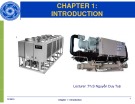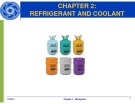Lecture Chapter 2 : Refrigerant - ThS. Nguyễn Duy Tuệ
Objectives lecture "Chapter 2 : Refrigerant" leaves: Understand the requirements of refrigerant and coolant, understand the thermodynamic and property of some refrigerants, use the refrigerant chart to display refrigeration cycle. Invite you to reference.



















